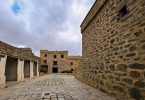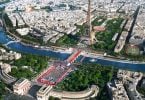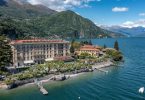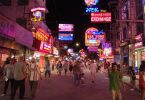There is no widespread tsunami threat in Puerto Rico, different from first reported by some media. However a local threat could be possible. A strong 6.5-magnitude earthquake struck at sea off the Puerto Rican coast at a shallow depth of less than 30 km early on Monday, the US Geological Survey reports.
The quake hit some 56 km off the northern coast of the island. The capital, San Juan, where 400,000 people live is located on the same side of the island.
No immediate injuries or damage has been reported. The tourism industry is extensive on this part of the island. The Pacific Tsunami Warning Center said the quake could trigger a local tsunami, but there is no threat for a widespread tsunami is in place.
The Puerto Rico quake on Monday comes almost exactly 4 years after a powerful 7.0-magnitude quake devastated another Caribbean island – Haiti.
The 2010 disaster took more than 100,000 lives and caused a humanitarian catastrophe in the nation, which remains one of the poorest in the world.
Seismotectonics of the Caribbean Region and Vicinity
Kusiyanasiyana kwakukulu komanso zovuta zamaulamuliro amtundu wa tectonic amadziwika ndi kuzungulira kwa mbale ya Caribbean, kuphatikizapo mbale zazikulu zinayi (North America, South America, Nazca, ndi Cocos). Madera omwe ali ndi zivomezi zakuya (zigawo za Wadati-Benioff), ngalande zam'nyanja, ndi mapiri a mapiri akuwonetsa momveka bwino kuchotsedwa kwa nyanja ya lithosphere m'mphepete mwa nyanja ya Central America ndi Atlantic Ocean ya Caribbean plate, pomwe kugwedezeka kwamphamvu ku Guatemala, kumpoto kwa Venezuela, ndi Cayman. Ridge ndi Cayman Trench amawonetsa kusintha kosasinthika komanso kolekanitsa ma tectonics a beseni.
Mphepete mwa kumpoto kwa mbale ya Caribbean, mbale ya kumpoto kwa America imayenda kumadzulo ndi kumadzulo kwa Caribbean plate pa liwiro la pafupifupi 20 mm / chaka. Motion imathandizidwa ndi zolakwika zingapo zazikulu zomwe zimapitilira chakum'mawa kuchokera ku Isla de Roatan kupita ku Haiti, kuphatikiza Swan Island Fault ndi Oriente Fault. Zolakwa izi zikuyimira malire akummwera ndi kumpoto kwa Cayman Trench. Kum'maŵa, kuchokera ku Dominican Republic kupita ku Island of Barbuda, kuyenda kwapakati pakati pa North America plate ndi Caribbean plate kumakhala kovuta kwambiri ndipo kumathandizidwa pang'ono ndi pafupifupi arc-parallel subduction ya North America plate pansi pa Caribbean plate. Izi zimabweretsa kupangidwa kwa ngalande yakuya ya Puerto Rico ndi malo a zivomezi zapakati (70-300 km kuya) mkati mwa slab yochepetsedwa. Ngakhale kuti chigawo cha ku Puerto Rico n’chakuti chingathe kuchititsa chivomezi chachikulu, sipanakhalepo zochitika zoterezi m’zaka 2 zapitazi. Chochitika chomaliza chotheka (cholakwika) pano chinachitika pa Meyi 1787, 1900 ndipo chinamveka pachilumba chonsecho ndi chiwonongeko chodziwika bwino kudutsa gombe lonse lakumpoto, kuphatikiza Arecibo ndi San Juan. Kuyambira 4, zivomezi ziwiri zazikulu kwambiri zomwe zachitika m'derali zinali chivomezi cha August 1946, 8.0 M29 Samana kumpoto chakum'maŵa kwa Hispaniola ndi chivomezi cha July 1943, 7.6 M12 Mona Passage, zonse zomwe zinali zivomezi zosazama kwambiri. Gawo lalikulu lakuyenda pakati pa mbale ya North America ndi mbale ya ku Caribbean m'derali likuyendetsedwa ndi zolakwika zingapo zomwe zimadutsa pachilumba cha Hispaniola, makamaka Septentrional Fault kumpoto ndi Enriquillo-Plantain. Garden Fault kumwera. Zochita zoyandikana ndi Enriquillo-Plantain Garden Fault system zidalembedwa bwino ndi chivomezi chowononga cha Januware 2010, 7.0 M1770 ku Haiti, zivomezi zomwe zidachitika pambuyo pake komanso chivomezi chofanana mu XNUMX.
Kulowera kum'maŵa ndi kum'mwera, malire a mbale amakhota kuzungulira Puerto Rico ndi kumpoto kwa Lesser Antilles kumene mbale yoyendayenda ya mbale ya Caribbean yokhudzana ndi North ndi South America mbale imakhala yochepa kwambiri, zomwe zimapangitsa kuti pakhale ma tectonics a pachilumba. Pano, mbale za kumpoto ndi ku South America zimadutsa kumadzulo pansi pa mbale ya Caribbean motsatira Lesser Antilles Trench pamitengo ya pafupifupi 20 mm / yr. Chifukwa cha kuchepetsedwa uku, pali zivomezi zapakati zomwe zimayang'ana mkati mwa mbale zomwe zidaphwanyidwa komanso mapiri ambiri ophulika pachilumbachi. Ngakhale kuti Antilles Aang'ono amaonedwa kuti ndi amodzi mwa zigawo zomwe zimagwira ntchito kwambiri ku Caribbean, zochepa mwa zochitikazi zakhala zazikulu kuposa M7.0 m'zaka zana zapitazi. Chilumba cha Guadeloupe chinali malo omwe zivomezi zazikulu kwambiri zomwe zachitika m'derali pa February 8, 1843, zinali zazikulu kuposa 8.0. Chivomezi chachikulu posachedwapa chakuya chapakati chomwe chinachitika m'mphepete mwa Lesser Antilles arc chinali chivomezi cha pa November 29, 2007 M7.4 Martinique kumpoto chakumadzulo kwa Fort-De-France.
The southern Caribbean plate boundary with the South America plate strikes east-west across Trinidad and western Venezuela at a relative rate of approximately 20 mm/yr. This boundary is characterized by major transform faults, including the Central Range Fault and the Boconó-San Sebastian-El Pilar Faults, and shallow seismicity. Since 1900, the largest earthquakes to occur in this region were the October 29, 1900 M7.7 Caracas earthquake, and the July 29, 1967 M6.5 earthquake near this same region. Further to the west, a broad zone of compressive deformation trends southwestward across western Venezuela and central Columbia. The plate boundary is not well defined across northwestern South America, but deformation transitions from being dominated by Caribbean/South America convergence in the east to Nazca/South America convergence in the west. The transition zone between subduction on the eastern and western margins of the Caribbean plate is characterized by diffuse seismicity involving low- to intermediate-magnitude (M<6.0) earthquakes of shallow to intermediate depth. The plate boundary offshore of Colombia is also characterized by convergence, where the Nazca plate subducts beneath South America towards the east at a rate of approximately 65 mm/yr. The January 31, 1906 M8.5 earthquake occurred on the shallowly dipping megathrust interface of this plate boundary segment. Along the western coast of Central America, the Cocos plate subducts towards the east beneath the Caribbean plate at the Middle America Trench. Convergence rates vary between 72-81 mm/yr, decreasing towards the north. This subduction results in relatively high rates of seismicity and a chain of numerous active volcanoes; intermediate-focus earthquakes occur within the subducted Cocos plate to depths of nearly 300 km. Since 1900, there have been many moderately sized intermediate-depth earthquakes in this region, including the September 7, 1915 M7.4 El Salvador and the October 5, 1950 M7.8 Costa Rica events. The boundary between the Cocos and Nazca plates is characterized by a series of north-south trending transform faults and east-west trending spreading centers. The largest and most seismically active of these transform boundaries is the Panama Fracture Zone. The Panama Fracture Zone terminates in the south at the Galapagos rift zone and in the north at the Middle America trench, where it forms part of the Cocos-Nazca-Caribbean triple junction. Earthquakes along the Panama Fracture Zone are generally shallow, low- to intermediate in magnitude (M<7.2) and are characteristically right-lateral strike-slip faulting earthquakes. Since 1900, the largest earthquake to occur along the Panama Fracture Zone was the July 26, 1962 M7.2 earthquake.






















